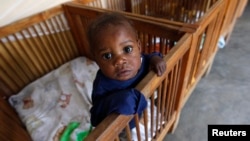A new report from the United Nations children’s agency, UNICEF, says violence against children is widespread across the globe. Among the disturbing findings, some 95,000 minors were murdered in 2012, and 120 million girls have experienced sexual violence.
Just because we do not always see violence against children does not mean it does not exist. This is the message of a new UNICEF report called “Hidden in Plain Sight,” which analyzes violence against children in 190 countries.
UNICEF Deputy Executive Director Geeta Rao Gupta said Thursday that violence plagues children around the world, regardless of their economic and social circumstances, culture, religion or ethnicity.
“It takes many forms: physical, sexual, emotional. It occurs in places where children should be safe: their homes, schools and communities. Increasingly, it happens over the Internet. And it is perpetrated by family members and teachers, neighbors and strangers, and other children," said Gupta.
Violence often starts in the home. Researchers found that nearly one billion children worldwide are subjected to physical punishment by their parents or caregivers on a regular basis. Children also experience violence at school, with one in three adolescents saying they were routinely bullied. And, according to the U.N. researchers, 120 million girls under age 20 have been subjected to forced sexual intercourse or other sexual acts.
Such abuse becomes normal and pervades attitudes, with the study finding that half of all teenage girls worldwide believe that a husband is sometimes justified in hitting or beating his wife.
Report author Claudia Cappa said that even if one child is harmed through an act of violence, it is one child too many.
“Violence against children does not only inflict pain and humiliation, it kills children. In 2012 alone, approximately 95,000 children and adolescents under age 20 were killed by homicides," said Cappa.
The report’s authors said efforts need to be made to change social attitudes about hitting children, and positive discipline methods need to be taught to lower the risk of violence in the home.
Services also need to be provided for children who have experienced psychological or physical abuse, and laws and policies that are meant to protect children must be enforced and implemented.





